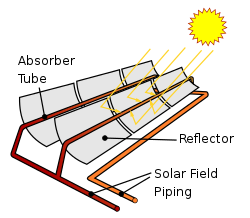Solar thermal energy
Solar thermal energy is a way of producing electricity in which the Sun's energy is concentrated by mirrors or lenses to either heat a fluid-filled pipe or drive a Stirling engine. The oil which is hot is circulated into a water storage system where it is used to change water into superheated steam, that then turns a turbine to generate electricity. The heat that is produced through this process powers a Stirling engine. The Stirling engine provides electricity and mechanical energy by having the fluid from within a cylinder expand, which then drives a piston that turns a shaft.
Solar thermal energy is primarily used domestically for space heating, hot water, and in some cases air conditioning. Solar thermal energy is renewable and no fuels are required during the process to generate electricity or mechanical energy. It is also carbon free except for production and transportation, otherwise it is non-polluting. Solar thermal can also be combined with photovoltaics (PVs), in highly efficient cogeneration systems. Some downsides are that solar thermal generates low grade energy, installation and construction costs are very high, it is expensive compared to conventional water heaters, and is hard to compete against cheap natural gas. An example of a Solar Thermal Electric Generation Plant is the Ivanpah Solar Electric Generating System that uses 300,000 computer-controlled mirrors, that focuses sunlight to the top of 459-foot towers, where water is turned into steam to power turbines.
Solar Thermal Energy Media
Roof-mounted close-coupled thermosiphon solar water heater.
MIT's Solar House#1 built in 1939 used seasonal thermal energy storage (STES) for year-round heating.
Solar Evaporation Ponds in the Atacama Desert.
Giant mirrors of the Solar furnace of Uzbekistan in Tashkent produce energy by collecting sunlight on photochemical eyes. Especially after the nuclear accident in Chernobyl, safety and environmental factors have become decisive in the selection of energy sources.
The solar furnace at Odeillo in the French Pyrenees-Orientales can reach temperatures up to 3,500° C (6300 °F).









